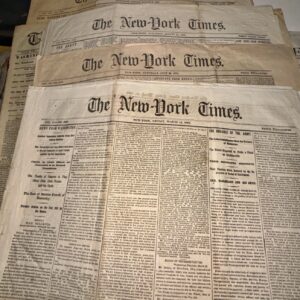ShopNovember 17, 2025
-

Excavated Confederate Forked Tongue Buckle
$650Excavated Confederate Forked Tongue BuckleNovember 16, 2025 -

Dug Confederate Tin Drum Canteen
$350Dug Confederate Tin Drum CanteenNovember 11, 2025 -

Complete Dug M1858 Civil War Smooth Side Canteen
$175Complete Dug M1858 Civil War Smooth Side CanteenNovember 11, 2025 -

Early 1870s Unusual Ad in the Form of a Decorative Blotter for Purchasing Ex-Civil War Union Soldier’s Homestead Grants – Offered by a Former Officer in the USCT Heavy Artillery
$175Early 1870s Unusual Ad in the Form of a Decorative Blotter for Purchasing Ex-Civil War Union Soldier’s Homestead Grants – Offered by a Former Officer in the USCT Heavy ArtilleryNovember 10, 2025 -

RESEARCH REVEALS SIGNIFICANT NEW INSIGHT INTO THIS IMAGE – Rare Outdoor Image of Two Armed Confederate Sailors with Two Union Captives from Union Ship the Alice Price
$2,350RESEARCH REVEALS SIGNIFICANT NEW INSIGHT INTO THIS IMAGE – Rare Outdoor Image of Two Armed Confederate Sailors with Two Union Captives from Union Ship the Alice PriceNovember 9, 2025 -

Large Clipped Point Civil War Period Stag Grip Bowie Knife
$1,850Large Clipped Point Civil War Period Stag Grip Bowie KnifeNovember 9, 2025 -

Die-Struck Excavated Sheet Brass Virginia Waist Belt Plate
Die-Struck Excavated Sheet Brass Virginia Waist Belt PlateNovember 8, 2025 -

Rare, 1865 Large Format Civil War Albumen of Petersburg, Va.
$550Rare, 1865 Large Format Civil War Albumen of Petersburg, Va.November 4, 2025 -

Group of Civil War Officer’s Rank Straps and Cap Insignia
Group of Civil War Officer’s Rank Straps and Cap InsigniaNovember 4, 2025 -

Civil War Type II Federal Issue Enlisted Man’s Forage Cap
$3,150Civil War Type II Federal Issue Enlisted Man’s Forage CapNovember 4, 2025 -

Group of Excavated Civil War Insignia and Breast Plates
Group of Excavated Civil War Insignia and Breast PlatesNovember 1, 2025 -

Group of Excavated Hat Letters and Numbers
Group of Excavated Hat Letters and NumbersNovember 1, 2025 -

Group of Excavated Civil War Period Mechanical Pens and Pencils
$195Group of Excavated Civil War Period Mechanical Pens and PencilsOctober 31, 2025 -

Excavated VMM Box Plate in Superior Condition
$1,500Excavated VMM Box Plate in Superior ConditionOctober 31, 2025 -

Civil War Union Infantry Officer’s McDowell Style Forage Cap
$3,500Civil War Union Infantry Officer’s McDowell Style Forage CapOctober 30, 2025 -

Id’d Presentation Grade M1850 Foot Officers Sword – Lt. George D. Hyatt Co. E 6th NY Heavy Artillery
$2,450Id’d Presentation Grade M1850 Foot Officers Sword – Lt. George D. Hyatt Co. E 6th NY Heavy ArtilleryOctober 29, 2025 -

Large Collection of Civil War Period Newspapers – Southern and Northern Wartime Editions
Large Collection of Civil War Period Newspapers – Southern and Northern Wartime EditionsOctober 28, 2025 -

Civil War Washington Naval Laboratory Box for .69 Cal. Cartridges Accompanied by Navy Cutlass Scabbard Sections, Seven .69 Cal. Rifle Bullets, Two USN Coat Buttons, a USN Boarding Pike Leather Cover, Brass Saber Bayonet Hilt and 12 lb. Schenkl Shell – All Discovered in the Potomac River in the 1960s
$1,100Civil War Washington Naval Laboratory Box for .69 Cal. Cartridges Accompanied by Navy Cutlass Scabbard Sections, Seven .69 Cal. Rifle Bullets, Two USN Coat Buttons, a USN Boarding Pike Leather Cover, Brass Saber Bayonet Hilt and 12 lb. Schenkl Shell – All Discovered in the Potomac River in the 1960sOctober 28, 2025


